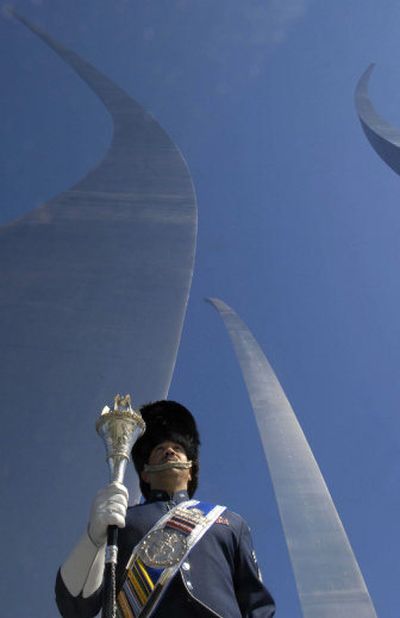U.S. unveils memorial for airmen killed in action

They all came Saturday, the avionics guys, the vice chiefs, the swaggering pilots, the military brats in shirts featuring photographs of their dads in Guam, and those who flew everywhere from the Russian coastline to the Persian Gulf.
Frank Veale Jr., 73, who joined the Air Force in 1950, arrived with an uncle on his mind, a captain in the old Army Air Corps who died after being captured in the Philippines. A few feet away, Walt McGinnis, 79, from San Antonio, and his son, Kevin, 46, talked in jest about how the elder McGinnis could have easily lost it over Korea.
“He got shot at a few times,” said Kevin McGinnis, a retired Air Force lieutenant colonel.
“You’re never scared,” the elder McGinnis said. “You’re just busy.”
Under a blue sky pierced by three curved spires soaring more than 200 feet in the air, thousands of veterans and family members armed with well-traveled war stories came to an Arlington, Va., promontory and a Pentagon parking lot for the dedication and official unveiling of the U.S. Air Force Memorial. For the Air Force, which had been the only military branch not to have its own Washington memorial, the dedication completed nearly 15 years of effort to build a monument to more than 54,000 airmen killed in action.
The dedication ceremony, which included speeches from President Bush and Defense Secretary Donald Rumsfeld, came nearly 60 years after the Air Force’s creation as a separate service. Near the memorial, hundreds of VIPs joined current and retired Air Force brass. They milled about its wide base, read inscriptions on adjacent granite walls, heard from dignitaries and watched the U.S. Air Force Band and Honor Guard perform.
Down by the Pentagon’s parking lot, where the jutting spires could be seen in the distance, other former airmen and their relatives toured military aircraft and visited information booths. Mostly, they shared old stories filled with talk of B-29s or C-141s and reminisced about the mundane tasks they just happened to perform on historic days.
Seaton Phelps, 84, from Edenton, N.C., sat in the parking lot, facing the distant memorial. He was part of the Air Force’s predecessor, the Army Air Corps. He served in England during World War II.
“I helped prepare the planes for the paratroops on D-Day,” he said. “We didn’t know what was going to happen. We just helped get the planes ready – C-4 gliders and C-47s.”
When asked what he thought of the memorial, he smiled. “I don’t know how to express it,” he said. “It’s just nice.”
By the ceremony’s end, Air Force Capt. Erica Rabe, 32, was standing beneath the spires, anticipating the famous “bomb burst” maneuver by the Thunderbirds. “We don’t have as much history as the other branches, but we have the same amount of courage, professionalism, dedication and patriotism, so it’s about time,” said Rabe, who added that her father was an Air Force pilot who recently died. “He would have loved to have seen this.”